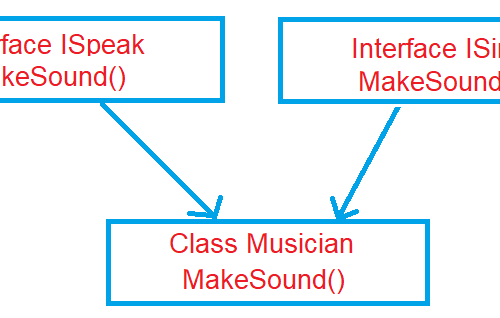Singleton Design Pattern in C# with Example A Step-by-Step Guide to Implementing the Singleton Design Pattern in C#
In the realm of software design, certain patterns emerge as go-to solutions for common programming challenges. One such pattern is the Singleton Design Pattern, which is particularly pertinent in C# development. In this article, we will delve into the intricacies of the Singleton Design Pattern and provide a comprehensive example of its implementation in C#.
Table of Contents
Introduction to Design Patterns
Design patterns are established solutions to recurring software design problems. They offer developers a common language and framework to address challenges systematically. The Singleton Pattern is a prime example, providing a solution for managing a single instance of a class throughout an application’s lifecycle.
Understanding the Singleton Design Pattern
The Singleton Design Pattern falls under the Creational category of design patterns. Its primary objective is to ensure that a class has only one instance, and it provides a global point of access to that instance. This pattern is especially useful when you want to control and restrict the number of instances created for a particular class.
Unlock the potential of software design with the Factory Design Pattern in C#, revolutionizing efficient object creation and code flexibility.
Benefits of Using the Singleton Pattern
- Efficient Resource Management: With only one instance, resources are allocated judiciously.
- Global Accessibility: The Singleton instance is accessible from anywhere in the application.
- Memory Conservation: Multiple instances of the same class are prevented, reducing memory consumption.
- Consistency in State: The Singleton guarantees that all parts of the application interact with the same instance.
Implementing Singleton Design Pattern in C# with Example – Step by Step
1. Private Constructor
To ensure that the Singleton class cannot be instantiated externally, its constructor should be made private. This prevents the class from being instantiated using the new keyword.
2. Private Static Instance
A private static variable holds the single instance of the class. This variable is typically initialized at the time of class loading.
3. Public Static Accessor Method
To access the Singleton instance, a public static method is provided. This method is responsible for creating the instance if it doesn’t exist, or returning the existing instance.
public class Singleton
{
private static Singleton _instance;
private Singleton() { }
public static Singleton GetInstance()
{
if (_instance == null)
{
_instance = new Singleton();
}
return _instance;
}
}
Ensuring Thread Safety in Singleton
In multi-threaded environments, ensuring that only one instance is created is essential. One common approach is using a lock mechanism to synchronize access to the instance creation process. Another approach is using the Lazy<T> class for lazy initialization.
Discover a wealth of C# interview questions by visiting our page on C# interview questions: C# Interview Questions.
public class ThreadSafeSingleton
{
private static readonly object _lock = new object();
private static ThreadSafeSingleton _instance;
private ThreadSafeSingleton() { }
public static ThreadSafeSingleton GetInstance()
{
lock (_lock)
{
if (_instance == null)
{
_instance = new ThreadSafeSingleton();
}
}
return _instance;
}
}
Real-Time Example: Logger Class
Imagine a Logger class that records application events. By implementing it as a Singleton, all logs are centralized and consistent, simplifying debugging and monitoring.
Singleton Design Pattern in Unity
In Unity game development, the Singleton pattern finds extensive use in managing game-wide resources such as game controllers or player inventories.
Explore the SOLID principles in C# for building robust and maintainable software architectures.
Singleton vs. Static Class
While both Singleton and static classes provide single instances, the Singleton pattern offers greater flexibility. Singleton classes can implement interfaces, inherit from classes, and modify instantiation behavior.
Common Mistakes and Misconceptions
New developers might overlook thread safety considerations or misuse the Singleton pattern. It’s vital to comprehend its intricacies to avoid such pitfalls.
When to Use the Singleton Pattern
Utilize the Singleton pattern when you require a single point of control for a resource or component. However, exercise caution not to overuse it, as it can lead to tight coupling between components.
Singleton Design Pattern Interview Questions
- How does lazy initialization impact the performance of the Singleton pattern?
- Is it possible to inherit from a Singleton class?
- What is the relationship between Singleton and global variables?
- Explain the concept of “double-checked locking” in the Singleton pattern.
- How would you implement the Singleton pattern in a multi-threaded environment?
Best Practices for Singleton Design Pattern
- Implement the Singleton pattern only when a single instance is genuinely necessary.
- Ensure thread safety to prevent issues in multi-threaded scenarios.
- Consider employing Dependency Injection to provide Singleton instances.
Real-World Example: Database Connection Manager
In database applications, a Singleton can effectively manage database connections, ensuring efficient resource utilization.
Explore the world of dictionaries in C# programming to efficiently manage and manipulate key-value pairs.
FAQ
What is a Singleton Design Pattern?
The Singleton pattern guarantees a class has only one instance and provides a global means to access that instance.
How does the Singleton Pattern ensure a single instance?
It achieves this by constraining the class’s constructor to private and offering a static method for access.
Can a Singleton class be inherited?
Yes, but careful implementation is necessary to maintain the Singleton pattern.
Is the Singleton Pattern thread-safe?
Not inherently. Ensuring thread safety requires deliberate implementation, especially in multi-threaded environments.
What are some alternatives to the Singleton Pattern?
Alternatives encompass the use of Static Classes or embracing Dependency Injection for managing single instances.
By implementing the Singleton Design Pattern in C#, developers can significantly enhance code structure, reusability, and overall performance. This pattern serves as a potent tool, enabling efficient resource management and consistent behavior across the application.
- How Does 5g Technology Enhance the Internet of Things : Unleashing the Power of Things
- How to Activate 5g in Jio Unlimited Data: Exploring Jio 5G Options!
- How to Enable 5g Unlimited Data in Airtel, Supercharge Your Phone with Airtel’s 5G!
- How Can I Activate 5g Instead of Lte, Want Lightning Speed 5G ?
- How Do I Activate 5g on My Iphone 13, Activating 5G on Your iPhone 13
- How to Activate 5g Airtel Unlimited Data, Activating Airtel Unlimited 5G Data (Simple Guide)
- How to Activate 5g Home Internet Verizon, Power Up Your Home with Verizon 5G Home Internet: Activation Guide
- How to Activate 5g Network in 5g Mobile, Activating 5G on Your Phone
- How to Activate 5g Unlimited Data in Airtel Thanks App, Activating Airtel’s Unlimited 5G with the Thanks App!
- How to Activate 5g Welcome Offer in Jio, Tapping into Jio’s 5G Speed: A Guide to the Welcome Offer
- How to Activate Airtel 5g in Airtel Thanks App, Activating Airtel 5G with the Airtel Thanks App!
- How to Activate Airtel 5g Unlimited Data on Iphone, Supercharge Your iPhone with Airtel 5G (if it’s available in your area)!
















